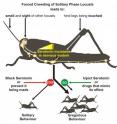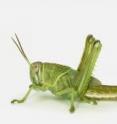Serotonin brings locusts together
Related images
(click to enlarge)
This press release is available in French, Japanese and Spanish. Researchers have linked the radical transformation of desert locusts – from harmless, solitary creatures to gregarious, swarm-forming insects – to the common brain chemical serotonin. This discovery illuminates a mechanism within these desert locusts that initiates their switch from aversion to attraction, and may open the door to new methods of pest control.
This report will be published by the journal Science on Friday, 30 January. Science is the journal of AAAS, the nonprofit science society.
With desert locusts, the expression of this swarming characteristic generally means serious trouble for any nearby farmers caught in the path of the swarm. Locusts are known to sometimes swarm by the billions, and they often devastate crop yields.
Dr. Stephen Rogers, an author of the Science paper from the University of Cambridge and the University of Oxford in the UK, said in a phone interview that the desert locusts they studied are "probably the worst kind. About twenty percent of the world is affected by this particular species."
Another author of the paper, Dr. Malcolm Burrows from the University of Cambridge, went on to say that, "This is a current problem. In the last few years, there have been major, devastating swarms in China, Africa, and Australia."
Although researchers had previously identified the sensory stimuli that trigger swarming behavior in locusts, this new finding reveals a neurochemical mechanism linking interactions among individuals to large-scale changes in population structure and the beginning of mass migration.
Although the discovery does not provide an immediate pest control solution, Paul Anthony Stevenson writes in a Perspective that these new insights "harbor considerable potential" for dealing with these harmful insects, if scientists can find viable ways to chemically convert swarming locusts back to their solitary phase.
Dr. Michael Anstey from the University of Oxford and colleagues including Dr. Swidbert Ott from the University of Cambridge and Dr. Rogers monitored the levels of serotonin in desert locusts while they triggered both solitary and gregarious behavior in the creatures. Their results show that locusts behaving the most gregariously (in swarm-mode) had approximately three times more serotonin in their systems than the calm, solitary locusts. This raises the prospect that individual neurons that drive this swarming behavior could be identified and targeted.
This kind of "switch" in desert locusts represents an extreme example of phenotypic plasticity, in which the expression of multiple observable characteristics can be generated from a single genetic characteristic. This plasticity, or adaptability, of desert locusts is evolutionarily important, and could help the insects prepare for increased competition for resources or signal necessary dispersal and migration cues.
Dwindling food sources seem to be one of those cues. Dr. Rogers says, "As their desert environment dries up, they look for food, which eventually brings them all closer together. They are looking for anything to eat, and when they run out of options, a swarm is basically inevitable."
Physically, desert locusts can be stimulated into swarming, gregarious behavior by either stimulation of the hind legs as they crawl over and jostle each other or by the combined sight and smell of other locusts. After enough of this "crowding," the locusts stop trying to avoid each other and begin coming together in a swarm.
Once Anstey and the team of researchers observed elevated levels of serotonin in swarming desert locusts, they tested whether or not both of these physical sensory pathways to swarming caused an influx of serotonin, and found that they both did. They also demonstrated that serotonin-inhibiting agents could allow locusts to remain calm and solitary despite the physical stimulation of crowding. On the other hand, injecting serotonin promoters into the locusts could induce swarming behavior even without that physical stimulation.
Serotonin is present in every multi-cellular organism on the planet, and serotonin receptors are often targeted by antidepressant drugs in humans to increase its availability. Dr. Ott says that, "many of the chemical agents that we used in this study to manipulate serotonin were at one time or another tested or used in clinical applications, such as the treatment of depression."
"It's really interesting," says Dr. Burrows. "Here we have a solitary and lonely creature, the desert locust. But just give them a little serotonin, and they go and join a gang!"
Source: American Association for the Advancement of Science
Articles on the same topic
- How a brain chemical changes locusts from harmless grasshoppers to swarming pestsThu, 29 Jan 2009, 19:29:10 UTC
Other sources
- How a brain chemical changes locusts from harmless grasshoppers to swarming pestsfrom Biology News NetMon, 2 Feb 2009, 18:14:54 UTC
- Chemical behind locust swarms foundfrom Science AlertSun, 1 Feb 2009, 20:35:16 UTC
- Chemical Gives Locusts A Jekyll-Hyde Joltfrom CBSNews - ScienceSun, 1 Feb 2009, 20:07:37 UTC
- Chemical behind locust swarms foundfrom Science AlertSun, 1 Feb 2009, 12:21:34 UTC
- How A Brain Chemical Changes Locusts From Harmless Grasshoppers To Swarming Pestsfrom Science DailySun, 1 Feb 2009, 4:35:04 UTC
- Scientists discover why locusts swarmfrom LA Times - ScienceSat, 31 Jan 2009, 6:56:23 UTC
- When Grasshoppers Go Biblical: Serotonin Causes Locusts to Swarmfrom Scientific AmericanFri, 30 Jan 2009, 21:42:21 UTC
- LOCUST SWARM PHOTOS: Plagues Triggered by Serotonin?from National GeographicFri, 30 Jan 2009, 18:35:06 UTC
- Secret of locust swarms uncoveredfrom SciDevFri, 30 Jan 2009, 17:14:10 UTC
- Serotonin may control locust, study showsfrom UPIFri, 30 Jan 2009, 17:07:14 UTC
- Common chemical causes locusts to swarmfrom MSNBC: ScienceFri, 30 Jan 2009, 2:14:14 UTC
- Study shows what makes locusts swarmfrom Reuters:ScienceFri, 30 Jan 2009, 0:56:06 UTC
- How a brain chemical changes locusts from harmless grasshoppers to swarming pestsfrom Biology News NetThu, 29 Jan 2009, 23:07:22 UTC
- Locust Swarms Switched On by Brain Chemicalfrom National GeographicThu, 29 Jan 2009, 22:14:04 UTC
- Chemical Gives Locusts A Jekyll-Hyde Joltfrom CBSNews - ScienceThu, 29 Jan 2009, 21:49:13 UTC
- Serotonin turns shy locusts into cereal killersfrom Sciencenews.orgThu, 29 Jan 2009, 20:56:23 UTC
- Serotonin May Be Key to Controlling Locustsfrom NY Times ScienceThu, 29 Jan 2009, 20:00:08 UTC
- How a brain chemical changes locusts from harmless grasshoppers to swarming pestsfrom PhysorgThu, 29 Jan 2009, 19:42:17 UTC
- Locust swarms 'high' on serotoninfrom BBC News: Science & NatureThu, 29 Jan 2009, 19:28:19 UTC
- Common chemical causes locusts to swarmfrom AP ScienceThu, 29 Jan 2009, 19:14:08 UTC


